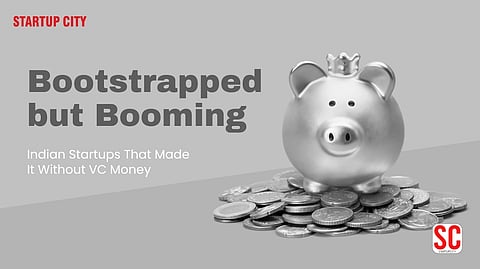

Let me ask you this — do you really need VC money to build a successful startup?
If you've ever felt sidelined because investors didn’t return your pitch emails, you're not alone. But here’s the truth — some of India’s most admired startups didn’t raise a single rupee from venture capitalists. And yet, they boomed.
Today, I want to take you through a different path — the less-glorified, but deeply powerful route of bootstrapping. If you're a startup founder trying to grow lean, smart, and resilient — this article is your playbook.
Before we dive into the real-world stories, let’s understand the why.
Bootstrapped startups are self-funded, either by the founders or through revenue generated from operations. But why do they turn down funding when it's easily available?
Here’s what I’ve learned from interviewing hundreds of Indian founders:
They want control. No dilution, no boardroom pressure.
They want profitability, not vanity metrics.
They grow at their own pace, not at the cost of burnout.
They believe in building businesses, not just valuations.
In short — they value freedom over fast cash.
These aren’t fairy tales. These are real, gritty, inspiring stories of Indian entrepreneurs who bootstrapped their way to millions.
When Nithin Kamath launched Zerodha in 2010, the broking space was crowded, regulated, and dominated by big players.
But guess what? He didn’t raise a single rupee.
Instead, he focused on:
Customer-first tech (low-cost, clean interface)
Word-of-mouth marketing
Transparent pricing
Today, Zerodha reportedly clocks over ₹2,500 crore in profits (as per FY23 data) — all bootstrapped.
“When you take money, you’re building to exit. We never wanted to exit.” – Nithin Kamath, Founder of Zerodha
2. Zoho – Quietly Building a Global SaaS Empire
While most startups head to Silicon Valley for VC backing, Sridhar Vembu went the other way.
He built Zoho from a small Chennai office to a global SaaS powerhouse with over 100 million users — all without external funding.
What worked for Zoho?
Building core tech in India
Investing in rural talent
Focus on product excellence over aggressive sales
Zoho’s secret? Long-term thinking over short-term growth.
Ever heard of VWO (Visual Website Optimizer)? It’s the flagship product of Wingify, founded by Paras Chopra.
Back in 2009, Paras built the tool himself, launched it globally, and made $1 million ARR within the first year, all bootstrapped from his bedroom in Delhi.
How did he do it?
Focused on solving a real pain point in CRO (conversion rate optimization)
Built a high-quality product before marketing
Targeted global SMBs from day one
Wingify proved that you don’t need funding if you solve a real problem brilliantly.
You may not associate Jalandhar with global tech, but that’s exactly where Kayako began.
Founder Varun Shoor started coding at 17, built a helpdesk SaaS product, and grew it into a company serving Fortune 500 clients.
All bootstrapped. All remote.
Eventually, it was acquired by ESW Capital — but without any VC money, Varun retained full control.
Refrens, an invoicing and payments platform for freelancers, is another modern-day example. Founded by Naman Sarawagi and Mohit Jain, it scaled steadily through:
Community-led growth
SEO-driven inbound leads
Lean operations with a micro-team
They showed that even in 2024, bootstrapping is still cool.
There’s no one-size-fits-all. But let’s break it down.
Criteria
Bootstrapped Startups
VC-Funded Startups
Ownership
100% founder-owned
Equity dilution
Growth
Sustainable, steady
Fast, aggressive
Control
Total freedom
Investor influence
Pressure
Low, self-driven
High, target-driven
If you're in a high-burn, high-scale market like Zomato or Paytm, VC may be necessary.
But if you're solving a real problem, can generate revenue fast, and want long-term control — bootstrapping can be your winning ticket.
Ready to take the plunge? Here’s how to do it wisely:
Charge from Day 1. Even if it’s small — validation with real money matters more than user count.
Don’t try to be everything for everyone. Niche audiences are easier to serve and monetize.
Content marketing + SEO = long-term organic leads without ad spend.
Small teams = faster decisions. Hire generalists who can wear multiple hats.
When you’re bootstrapped, cash flow is king. Use tools like Razorpay, QuickBooks, or even Google Sheets.
You don’t need a pitch deck to start — you need grit.
You don’t need connections — you need customer obsession.
You don’t need funding — you need a problem worth solving.
Let me say this clearly — bootstrapped doesn't mean small.
It means building your dream your way.
Imagine this — your product, your pace, your profits. No investor calls. No burn rates. Just value creation, on your own terms.
If that excites you, then you're already on the right path.
Bootstrapping isn’t for everyone, but it might just be perfect for you.
So, what’s your startup story going to be?
Are you building something incredible without VC money?
Share your story with us at Startup City India — we’d love to feature you in our next big story.